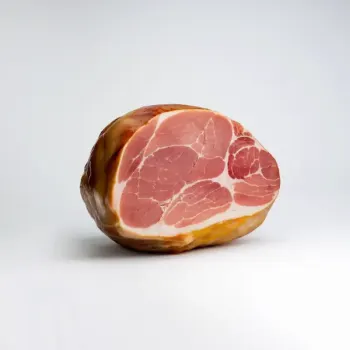Ham and Pancetta are two distinct pork products used in cooking for their unique flavors and textures; ham being leaner and milder, while pancetta is fattier and more robust. They can be used interchangeably in recipes with adjustments for taste and fat content.

Ham is a cut from the hind leg of a pig, typically cured and sometimes smoked. It's celebrated for its rich flavor and versatility, ranging from deli slices to whole holiday roasts.

Pancetta is Italian pork belly, salt-cured and spiced with pepper and other seasonings. It's commonly sold rolled up into a log and sliced thinly, known for adding a punch of flavor to dishes.
While both are pork products, ham is typically leaner and comes from the leg, whereas pancetta is fatty, coming from the belly. Ham has a sweet and smoky profile, while pancetta offers a salty, robust flavor. Their textures also differ; ham being firm and dense, and pancetta being soft and fatty.

Your ultimate Recipe Box, Meal Planner, and Cooking Class all in one
In pasta dishes like Fettuccine Alfredo or Peas and Ham Pasta, ham provides a smoky sweetness and a chewy texture. It's best used when a subtle, less fatty meat is desired. Pancetta stars in dishes like Spaghetti Carbonara and Bucatini all'Amatriciana, where its fat renders into the sauce, imparting a rich, savory depth. It's perfect for when a bold, fatty flavor is the goal.
Ham can be diced into salads such as Chef's Salad or a classic Cobb, adding a lean protein with a smoky note without overpowering other ingredients. Crisped pancetta bits work wonders in salads like Spinach and Pancetta Salad or a warm Potato Salad, offering a pleasant crunch and a salty contrast to fresh greens.
Ham bones and chunks are ideal in comforting soups and stews like Split Pea Soup or White Bean and Ham Hock Stew, contributing a smoky base and hearty texture. Pancetta can be rendered at the start of cooking to create a flavorful foundation for soups and stews like Minestrone or Lentil Soup, enriching the dish with its fat and savoriness.
Both ham and pancetta are rich in protein, but their fat content differs significantly.
| Nutrient | Ham ( per Ounce ) | Pancetta ( per Ounce ) |
|---|---|---|
| Fat | 1g | 6g |
| Sodium | 270mg | 300mg |
| Calcium | 0mg | 0mg |
| Protein | 5g | 3g |
| Calories | 30 | 70 |
| Carbohydrates | 0g | 0g |
Yes, you can use pancetta instead of ham, but be mindful of the fattier texture and stronger flavor pancetta brings to the dish.
It depends on the recipe. Use ham for a leaner, milder taste, and pancetta for a richer, more robust flavor.
Yes, ham is often eaten as is or baked, while pancetta is usually rendered or crisped up in a pan before adding to recipes.
Not always. Their different fat contents and flavor profiles can affect the dish's outcome. Always consider these factors when substituting.
Yes, pancetta is saltier than ham, so you may want to reduce added salt in the recipe to compensate.